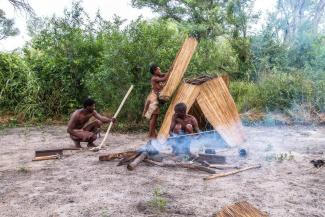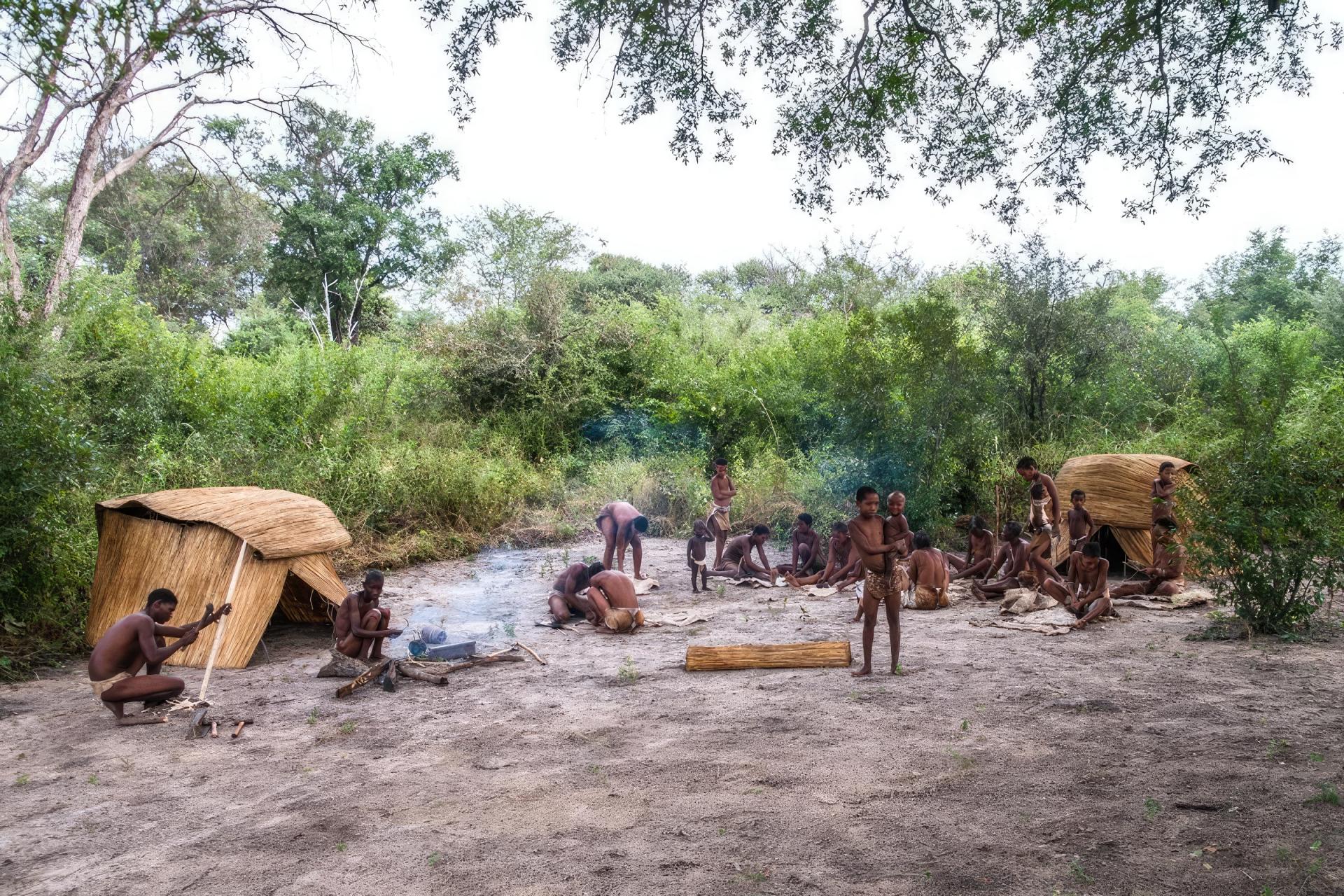
The San and Khoikhoi Peoples in Namibia, Botswana, and South Africa have a legacy of living in close harmony with nature. Despite a history of discriminatory environmental control and exclusion from their land, Indigenous communities across southern Africa are champions of wildlife. In southern Africa, where marginalized and impoverished communities coexist with some of the world’s most iconic and dangerous species, Indigenous-led governance offers a new path for conservation.
The philosophy of Community-Based Natural Resource Management (CBNRM) was pioneered in post-colonial southern Africa during the 1980s–90s. This rights-based reform aimed to decentralize authority and foster shared decision-making processes. While CBNRM is not a perfect system, it is an attempt to support Indigenous Peoples with potential decolonizing effects for land stewardship on communal land. As protected areas often fail to support biodiversity and perpetuate exclusion of Indigenous people, governance of customary land is critical for effective and socially just conservation models.
Post-apartheid Namibia offers one such example, having developed a successful CBNRM system with 86 registered
communal conservancies covering about 20 percent of the country’s land area and supporting more than 230,000 rural people. Today, Namibia’s conservancy program is recognized as a leading global model for recovering wildlife populations, improving livelihoods, and building powerful democratic institutions by granting land and wildlife use rights directly to communities through national legislation. Initiatives such as local hunting quotas allow access to wildlife resources, while community game guard programs support stewardship leadership and a culture of wildlife protection as well as providing an important source of employment. Promoting gender equality is also a governance priority.
The sustainable use of wildlife has been a catalyst for the development of Namibia’s conservancies over the last three decades, as have similar programs in Botswana, Zambia, and Zimbabwe. Progress has been achieved by securing Indigenous Peoples’ rights, supporting traditional hunting values, and ensuring access to game meat. In addition, application of hunting tourism delivers revenue that facilitates new financial management systems and increased accountability of new communal institutions.
UN Special Rapporteur on the rights of Indigenous Peoples, José Francisco Calí Tzay (Kaqchikel Maya), explained the concept and benefits of community-based natural resource management in detail in his Tourism and the Rights of Indigenous Peoples Report: “In Southern Africa, Indigenous Peoples have formed community-based organizations to engage in community-based natural resource management of wildlife and other resources on their communal lands to generate income from tourism. Revenues from hunting expeditions are distributed to the broader community and, in some countries, shared with government. Economic benefits take the form of cash distributed to households or investments in larger community projects (for example, schools, medical clinics, electricity, water).
Community-based organizations offer employment opportunities, hiring administrative staff and community guards, scouts, and rangers to conduct anti-poaching patrols, to assist in reducing human-wildlife conflict, and to educate members of the community on the importance of conservation. Agreements entered into with the private sector often include clauses for local employment and training."

The Kyaramacan Association within Namibia’s Bwabwata National Park, made up of about 6,000 Indigenous Khwe people and other park residents, is an example of the economic development generated from sustainable hunting tourism. These benefits were recognized in a 2013 report by then-UN Special Rapporteur on the Rights of Indigenous Peoples, James Anaya (Apache and Purépecha), to the UN Human Rights Council. The Kyaramacan Association has since built a Traditional Knowledge center to educate visitors and strengthen San culture. None of this support would be possible without the economic benefits from hunting tourism that are now under serious threat.
The international hunting industry is not without its own colonial legacies, like many photo-tourism experiences and western conservation practices. The unfair eviction of Maasai people from the Loliondo area of northern Tanzania
for use by foreign royal elites, for example, must not be condoned. However, in many areas of southern Africa, hunting tourism is a sustainable business model done in joint partnership with communities. The proceeds contribute to building schools, clinics, bursaries, and water boreholes, among other infrastructure and social services, while also increasing household income. Action is also being taken to improve local participation in the industry, from quota setting and marketing to innovative shared business ownership models.
Indigenous Peoples, local communities, and the Community Leaders Network of southern Africa are calling for greater inclusion in wildlife policy making, transparent consultation by domestic and foreign governments, and legitimate engagement in conservation practice. This was a major topic of discussion at the recent Africa Protected Areas Congress held in Rwanda in 2022, which resulted in the Kigali Call to Action to “[support] the livelihoods of local communities through sustainable use and employment, especially through tourism.”

Khwe (San) community members at the Khwe Living Museum in northern Namibia.
The role of Indigenous Peoples in land stewardship is recognized by multilateral environmental agreements such as the UN Convention on Biological Diversity, Convention on International Trade in Endangered Species of Fauna and Flora, and the International Union for Conservation of Nature, among other influential bodies. Despite this growing global support and recognition for Indigenous Peoples, however, eco-colonialism remains active in many aspects of conservation, encouraged by a westernized wildlife ideology that dehumanizes Black Africans. Such unabashed ignorance is frequently on display in political debates and media narratives, particularly regarding wildlife trade policy.
Indigenous communities in Africa are concerned with the proliferation of import bans on legally harvested wildlife targeting iconic African species such as elephants and lions. These legislative proposals or administrative rules often use neo-colonial messaging, lack scientific credibility, disregard national sovereignty in wildlife management, and disenfranchise local people from the real benefits of hunting tourism. Wildlife trade restrictions driven by misinformed public opinion in the global north threaten the conservation successes of CBNRM programs in southern Africa.
The right to development and benefit from the sustainable use of wildlife is being championed by Indigenous Peoples as an Indigenous Peoples’ rights issue. A recent Convention on International Trade in Endangered Species working group meeting in Cusco, Peru highlighted the challenges of implementing meaningful engagement of Indigenous Peoples and local communities in international regulation. The Community Leaders Network of southern Africa actively participated in this arena, making connections with representatives of the Māori Peoples from New Zealand who are interested in trading ceremonial specimens of worked sperm whale bone. We need to establish more linkages with Indigenous Peoples from around the world to form a collective voice and leadership position elevated in international policy debates. Last year, a delegation from southern Africa attended the 23rd UN Permanent Forum on Indigenous Issues. This group will be present again in New York in 2024 to find solidarity with other Indigenous Peoples globally.
Much work remains to be done to create more robust and egalitarian wildlife economies, moving beyond meager benefit sharing schemes to transformative social and environmental justice change that better incorporates Indigenous knowledge systems in land stewardship. We ask for mutual respect between divergent wildlife use values and call for support from the international community to defend the self-determination of Indigenous Peoples through community-based sustainable use of wildlife. Community-based conservation must also evolve to include pursuit of more absolute land tenure and to realize additional sustainable development gains from tourism.
Hunting that supports community-based natural resource management programs continues to play a vital role in the movement to support Indigenous communities in managing their lands and resources and protecting biodiversity.
-Lesle Jansen (Khoikhoi) is Head of Indigenous Peoples and local communities resource rights at Jamma International, a nonprofit organization that supports meaningful conservation work for the well being of the planet and its people with a focus on Indigenous Peoples’ rights to community-based natural resource management in southern Africa. Joe Goergen is an International Policy and Public Affairs Specialist at Jamma International.
Top photo: Khwe (San) community members build with traditional materials and pass on Indigenous knowledge to the next generation. Photos courtesy of Khwe Living Museum, Living Culture Foundation Namibia.
